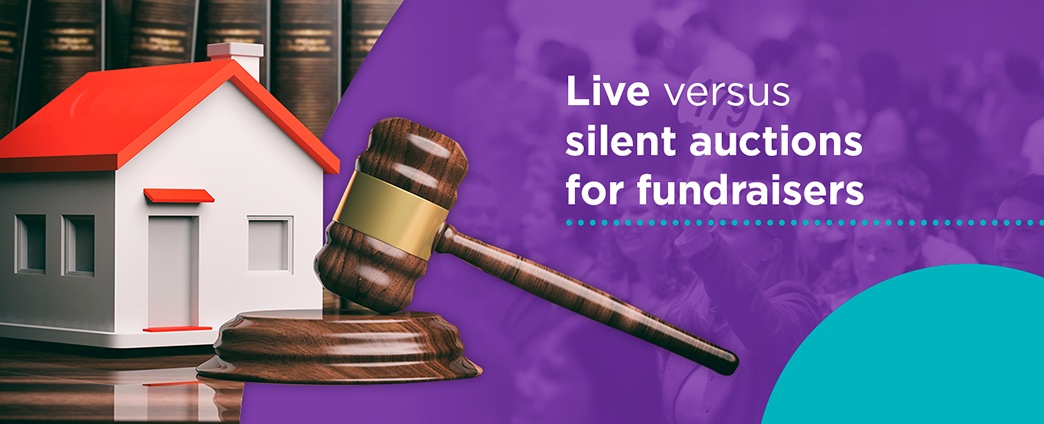Jan 15, 2021
Live vs. Silent Auctions for Fundraisers

Differences Between Live and Silent Auctions
Benefit auctions are a tried-and-true way to drum up spirits — and funds — for nonprofits.
Combining an upbeat, social evening with a good cause, many organizations put on auctions with the goal of reaching a fundraising quota through the successful bidding and sale of auction items. Yet as any nonprofit director or program coordinator knows, conducting fundraising is never as simple as setting a goal, contacting a few friends and watching the funds stream in.
Are you hosting a silent or live auction for your nonprofit’s fundraising initiative? Interested in one? GiveSmart’s live versus silent auction guide will have you walking and talking like a seasoned nonprofit auctioneer — minus the rapid-fire speech. We’ve got tips and tricks to procure the right auction items, invite the right guest list, incentivize bids and create a knockout atmosphere aligned with your fundraising goals — all to keep your nonprofit’s mission thriving.
What Is a Silent Auction?
Silent auctions stage merchandise on various tables and displays for attendees to look over at their own pace then bid on via written pledges. Those bids sit on display near their associated items for the next person to review, determining how much they want to exceed the last bid to secure their chance of winning that item.
Successful silent auctions can last anywhere from one hour to one day. They trade the fast-paced, auctioneer-led and item-by-item bidding of their live auction cousins for more self-directed merchandise perusings, almost like a retail store experience. Once the written-bid timeframe is up, auction organizers announce the winners and then orchestrate item checkout and delivery.
What Are the Best Use Cases for Silent Auctions?
Given their relaxed, independent structure, silent auctions are best held alongside other nonprofit events or festivities. Their inclusion into an existing program enriches that program’s offerings while also enabling nonprofits to expand their social presence and impact.
Those in the nonprofit sector looking to spark their fundraising initiatives can look to add a silent benefit auction onto:
- Current donor gatherings: Do you host quarterly, biannual or annual celebrations for those who’ve already expressed interest or supported your work? Make the most of their next gathering with silent auction items geared toward key donor interests and personas.
- Included alongside other nonprofit events: Dances, festivals, performances, farmers markets — the list goes on. Whenever significant pools of donors, volunteers, colleagues and the general public congregate in your nonprofit’s name, consider adding a few dozen silent auction items to bid on during the day.
- Available online: Online auctions are more prevalent than ever, made possible through silent auction and fundraising software designed exclusively for nonprofits.
What Types of Items Sell Best at a Silent Auction?
Items included in the silent portion of a charity auction statistically receive lower bids than those in a live, curated one. However, lower bids are not synonymous with lower-quality merchandise. You can still incentivize competitive bidding and high rates-of-return for the majority of items by following these silent auction merchandise ideas:
- Themed basket: You may have heard the saying before that something is more than the sum of its parts. Well, the same holds true for silent auction merchandise. Grouping compatible or themed items together into one larger basket drive up bids versus what the items would obtain on their own. Your nonprofit raises more money and your bidder earns more desired goodies — a win-win for all.
- Tickets: Sporting events, theater performances, concerts, ballets, comedy shows and other ticketed venue items make great silent auction add-ons.
- Local business deals: Restuarant coupons, free or reduced local business services, boutique or shopping gift cards and more deals, all for trendy area establishments.
- Sports gear: Golf clubs, fishing tackle sets, skiing or snowboarding gear and more.
- Private lessons: Tennis, painting, acting, musical instruments, financial advisement sessions and many other one-on-one skill-based or technical tutorials.
- Food and beverages: Craft beer collections, stocked wine racks, chocolate lover’s baskets and other crave-worthy goods.
Pros of a Silent Auction
Silent benefit auctions contribute many advantages to your nonprofit’s fundraising efforts:
- Cost: Hosting a silent benefit auction will be significantly cheaper than a live auction, since elements such as hiring an auctioneer or catering a multi-course dinner are not so expected.
- Approachability: The written bid format may be far more comfortable for some personalities, who could be intimidated by the brash, speedy and competitive pace of live auctions.
- Fewer formalities: Silent auctions are self-directed, meaning they don’t contain nearly as many curated events or details. Guests can enjoy the space to socialize and interact with one another a bit more freely, plus spend time at other event activities like dancing, rides, games or raffles.
- Digital affordances: Online silent auctions add the bonus of an expanded donor pool, one uninhibited by location or physical mobility.
Cons of a Silent Auction
Add these to your list of silent auction event considerations:
- Scale: It’s essential to strike a Goldilocks balance between how many silent auction items are available and actual event attendance to keep written bids competitive. The industry’s rule of thumb? Divide your attendance list by two, then source that many items for your auction.
- Item presentation: Items displayed in engaging, aesthetic ways are items that attract eyes — and therefore bids. Mix and match various item stands, display cases, colors and tiers. Also, make sure every table comes with a theme-relevant tablecloth and tabletop decorations.
- Check-in and check-out procedures: To prevent fraud and remain compliant with IRS auction regulations, your silent auction must have proper guest check-in and checkout procedures, ensuring seamless winner identification, payment methods, inventory management and item delivery.
Many of the downsides to a silent auction are mitigated through nonprofit event fundraising software, which can manage everything from event ticketing and registration down to auction item cataloging and guest communications.
What Is a Live Auction?
Live auctions evolve around a basic premise — gather a group of people to bid over select goods, gifts and packages in real-time, live increments, with the highest bidder taking home the prize. Trained auctioneers typically facilitate the bidding, orchestrating the evening with grand presentations and drumming up bids for individual items, plus a good dose of finesse sprinkled atop stage presence.
Live charity auctions are a popular fundraising vehicle for nonprofits due to their high-energy, high-bid environment. All proceeds gleaned from live auction attendees and their bids go toward a charitable cause, either a sponsored program or the nonprofit hosting the auction itself. This video is a great explainer of live vs. silent auctions.
What Are the Best Use Cases for Live Auctions?
The atmosphere of a live auction makes them well suited to be their own standout event. A successful live auction requires near-complete crowd captivation, drawing enthusiasm and curiosity over items brought to the stage. Packaging live auctions as part of another program or fundraising vehicle will likely detract from this momentum and reduce attendees’ attachment to the items for sale.
It’s best to host a live auction next time your nonprofit intends:
- To conduct its focal fundraising event: Annual or biannual funding drives are a pillar for most nonprofits. Live auctions serve as a great alternative to traditional annual funding methodologies, infusing new life into these efforts.
- To promote its mission and identity: This is especially important for younger nonprofits looking to widen their community footprint. Live auctions can quickly become a unique networking opportunity to mix and mingle with area corporate sponsors, nonprofit leaders, individual target donor segments and local influencers.
- To conduct beginning or end-of-year ceremonies: Many nonprofits kick off or wrap up the calendar year with a signature event to promote upcoming initiatives as well as reflect upon and appreciate the past year’s successes. A live benefit auction lends a great celebratory atmosphere to such ceremonies.
Of course, scaled-down live auctions can be incorporated into other nonprofit fundraising events. If your organization chooses to do this, reduce the number of items up for bidding. Five to ten should suffice without overwhelming the other aspects of the event.
What Types of Items Sell Best at a Live Auction?
All items up for auction have on thing in common — they’re relevant and on-brand for the event’s audience.
Consider a few examples. If the majority of your fundraising auction attendees will be retired senior citizens, items like high-end fishing tackle sets and all-expense golf outings may be more pertinent. If the audience is predominantly women, perhaps items like a spa package or designer handbags will be more desirable.
Tailoring auction items to your core audience is part of an overall nonprofit marketing strategy involving donor personas. If you know your nonprofit’s major audience, you know how to tailor messages and events to drive engagement.
Research indicates certain kinds of goods do, in fact, sell higher during live auctions rather than silent, passive ones. These items include:
- Experiences: Think weekend bed-and-breakfast getaways, truffle-making courses, cruise packages, city bar crawls and more.
- Rare finds: First-edition collections of books, novelty television show memorabilia, rare bottles of liquor and other luxe or limited-edition items.
- Celebrity paraphernalia: Signed jerseys and sports equipment, photographs, meet-and-greet sessions and more.
- Artwork: Custom paintings, photography, pottery, sculptures and family portrait sessions.
- Vacation packages: Particularly all-inclusive travel packages featuring transportation, lodging and one to three free activities or amenities.
- Upscale “foodie” events: Privately catered dinner parties, behind-the-scenes brewery tours, vintage wine tastings, sushi-making classes and more.
Pros of a Live Auction
There are numerous benefits to hosting a live auction fundraiser for your nonprofit:
- Atmosphere: Few fundraising initiatives match the energy and engagement provided by a live benefit auction. What’s more, these events are typically themed, allowing guests to dress up and step outside the everyday just by attending.
- Expediency: Professional auctioneers curate a sense of urgency with every item brought to the stage. They motivate bids and encourage that in-the-moment rush every time someone lifts their bidding paddle.
- Entertainment: The upbeat atmosphere of live auctions lends itself well to complementary event entertainment. Think live music or comedy sketches sprinkled intermittently throughout the night to make the occasion that much more memorable.
- Larger-than-life event: The venue, decorations, dinner courses, stage, theme, an auctioneer — each of these elements comes together to form a truly special occasion for all in attendance — plus one where your nonprofit can “let its hair down” and celebrate.
Cons of a Live Auction
While live auctions carry a distinct buzz hard to replicate with other events, they’re not without their drawbacks:
- Cost: Unless your nonprofit holds a large event hall, you’ll likely need to book an external venue to host your auction. Yet this won’t be the only expenditure involved. You’ll need catering for dinner and dessert, drinks or an open bar, sufficient tables, seating, bid paddles, decorations, item storage and likely a professional auctioneer facilitating the entire event. While many nonprofits reduce auction overhead by getting such items donated, including a pro-bono auctioneer, overall costs still stack up.
- Organization: Planning a nonprofit fundraiser will take significantly more time and effort than event alternatives, including a silent auction. Program coordinators should begin auction preparations a minimum of eight months to a year in advance.
- High-value item procurement: Live actions live or die by the amount of high-market value items secured for participants to bid on. Nonprofits will need diverse, valuable and target-relevant merchandise to put on the best event.
- Less socialization: Live auctions are inherently more structured than other nonprofit initiatives, particularly if they include a dinner with arranged seating and live entertainment. Less socialization and free-flowing movement could be a turnoff for some target donor personas.
Why Not Both? Events With Both Live and Silent Auction Fundraising
The average rate of return for an auction item will be 50 to 65 percent of its fair market value. That means, for example, for a pair of tickets valued at $100, you can reasonably expect benefit auction attendees to pay around $50 to $65. Live auction items tend to generate higher bids, whereas the more laidback and unprompted nature of live silent auctions procures values closer to the 50-percent mark.
Why not combine both live and silent auctions to maximize your fundraising event? There are numerous examples of ways nonprofits can merge the two:
- Alongside 5K walks, runs or similar charity sporting tournaments
- Integrated into awards night, with a live auction taking place after the awards but an omnipresent silent auction
- Staggered during holiday parties or celebrations
- In the evening or nighttime hours of a festival or carnival
- Added to game or trivia nights
How Silent Auction Software Can Improve Your Event
On average, silent auction software increases bidding amounts by 30 percent. By swapping those self-directed, paper-based bids for a dynamic yet convenient online platform, these applications can open your nonprofit up to a world of new donors and fundraising amounts — literally — plus these other event improvements:
- They’re cost-effective: Sponsoring an online auction costs a fraction of the amount compared to hosting a physical one because it requires hardly any additional infrastructure. Why spend money to raise money when you don’t have to?
- They expand your bidder pool: Anyone can browse and bid on auction inventory, regardless of their physical location. This remote capability is particularly great for senior citizens or those with physical impairments making it difficult to quickly raise paddles or maneuver around crowded silent auction tables.
- They’re more organized: Many behind-the-scene aspects of putting on an auction — from storing item inventory and setting up event tables to checking in and checking out guests — is simplified, if not eliminated, by online software. For bidders, items are displayed in a clean, intuitive and user-friendly catalog, with a clear inventory number, fair market value listing and item description. For organizers, you can calculate fundraising profits, update bid deadlines, track inventory and send inter-organization updates with a few clicks.
- They eliminate checkout headaches: Properly matching won items with guests at check-out can be confusing and cumbersome, especially if the hour is late. Silent auction software manages inventory, payment and delivery details for you.
- They work: Simplify, streamline and automate many of the tasks that make charity auctions such a grand organizing ordeal so your fundraiser draws in higher dollars with less oversight.
Request a Demo of GiveSmart’s Silent Auction Management Software Today
Our mobile bidding and online auction program has helped raise over $2 billion in just seven years for nonprofits across the country. Request a free program demo, and discover for yourself what live online auctions can bring to your nonprofit.
Related



